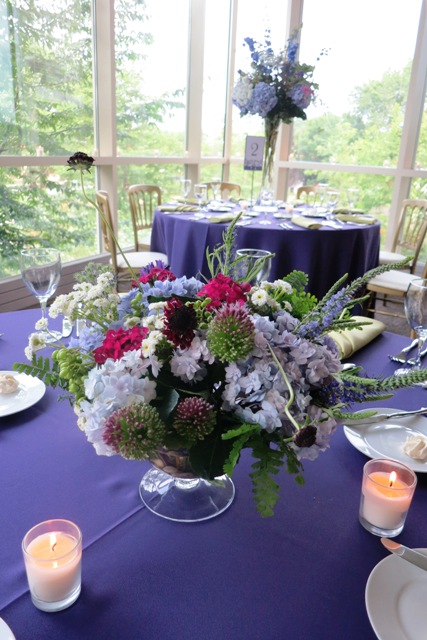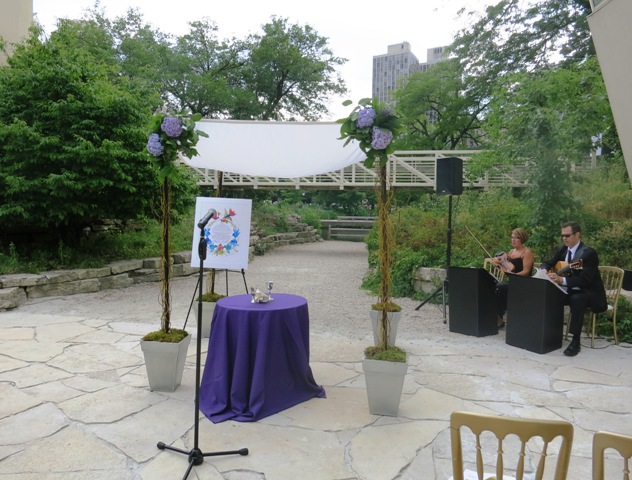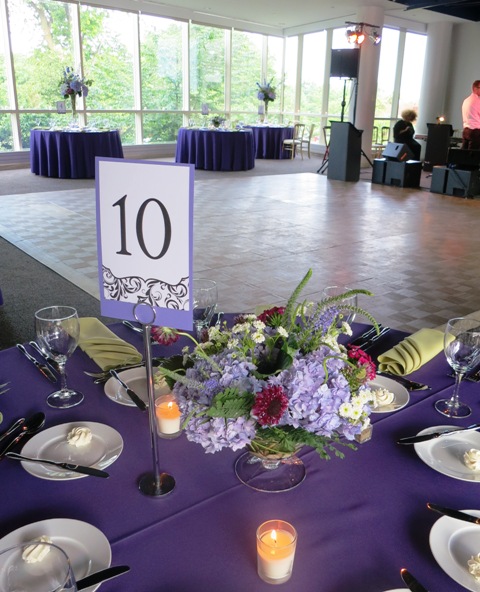Rachel and Jason’s wedding at the Peggy Notebaert Nature Museum reminded me that there are many little things, easy to overlook, that we at Pollen do to minimize the ecological impact of our clients’ weddings. Some are more obvious, liking working with locally grown flowers whenever possible. Others are less obvious. Here are a couple of the easy-to-miss things we do to be more eco-friendly, illustrated through yesterday’s wedding.
 Avoiding Floral Foam:
Avoiding Floral Foam:
This is a biggie. We have nearly entirely eliminated our use of floral foam, and yesterday’s wedding was another step toward foam-freedom. Why avoid floral foam? It’s a petroleum product, and we don’t need more reasons to be digging around for oil, do we? Floral foam doesn’t biodegrade. And it contains formaldehyde. When cut while dry, it creates a dust that the person cutting it can’t help but inhale. My fellow florists can attest to the evidence of this inhalation, seen when one blows his or her nose after cutting dry floral foam. Gross, yes, but illustrative, no?
There are just a few applications left that I haven’t yet been able to figure out how to avoid using floral foam. One of those was to decorate structures, such as chuppahs. What to do? I went old school: chicken wire. I bundled up some chicken wire, secured it to the chuppah, and added the foliage and flowers on site.

Another application requiring some trial and error in order to avoid floral foam was in designing tall centerpieces. Usually those are designed in floral foam that is taped to a tray, then the tray then is set on top of the tall vase. Instead of going this route, I’ve been using a tall vase and designing directly in the vase, with the stems in water. Getting a perfect sphere of flowers is tricky with this technique, but most of my clients are looking for a looser outline, which works out perfectly!
And yet another challenge is when designing in low bowls. In this case, I went old school again and used floral frogs in the containers. Floral frogs come in a few different forms, including glass ones with holes in them and metal ones that look like a bunch of pins sticking up. I used the latter in these low glass bowls, then put in some small rocks to camouflage the frog.
Below you can see a low centerpiece, as well as the tall centerpieces in the background.

On the table, we provided soy wax candles to provide soft light once the sun set. We also lined the window ledges with votive candles. Speaking of our candles…
Thoughtful Candles
The clients chose Pollen to provide the candles because we offer soy wax votive candles, which we have refilled by Bright Endeavors. Most candles are made from paraffin wax. You guessed it: another petroleum product. Soy wax votives burn cleaner and are plant-derived.
Many times after weddings and events, the votive candles simply get thrown out. It’s cheaper to buy new ones than the cost of having someone remove the stubborn paraffin wax from spent candles. Soy wax, on the other hand, is quite easy to remove. Pollen partners with Bright Endeavors, a social enterprise that provides job skills training to women at risk for poverty while producing eco-friendly bath and candle products. Bright Endeavors offers a votive refill program that allows us to bring back our spent votives again and again to be refilled with soy wax.
Even for our clients that don’t prioritize sustainability in their wedding planning, we’re working in ways that minimize waste in our business, and therefore at their weddings. For those who place value on sustainability, Pollen is the perfect florist to work with to host a greener wedding.
Thank you so much for this post. We, too, are trying creative ways to avoid using floral foam in our designs. Thanks for educating others about its impacts!
Awesome post. I am always sad about how many votive candles I see tossed at the end of a wedding! Gonna check in with you next time a client needs them…